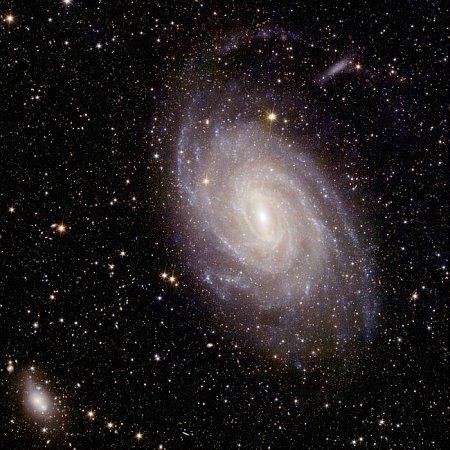Euclid releases new images and first science results
The Euclid science team today released five early science images in connection of the publication of ten papers.
The picture to the right is one of those images, cropped, reduced, and sharpened to post here. From the caption:
In this image Euclid showcases NGC 6744, an archetype of the kind of galaxy currently forming most of the stars in the local Universe. Euclid’s large field-of-view covers the entire galaxy, capturing not only spiral structure on larger scales but also exquisite detail on small spatial scales. This includes feather-like lanes of dust emerging as ‘spurs’ from the spiral arms, shown here with incredible clarity.
Scientists are using this dataset to understand how dust and gas are linked to star formation; map how different star populations are distributed throughout galaxies and where stars are currently forming; and unravel the physics behind the structure of spiral galaxies, something that is still not fully understood after decades of study.
Euclid is a wide-field space telescope that has instruments that observe in both visible and near-infrared wavelengths. Its primary mirror at 1.2 meters is half the width of Hubble’s. More details about these early images and links to the new science results can be found here.
Unlike Hubble, it appears Euclid will not be used as a general observatory, at least initially. Its primary goal is to do a survey of one third of the sky, focusing on extragalactic sources outside the Milky Way. Once this is complete however it is possible the space telescope will be made available for other observations.
On Christmas Eve 1968 three Americans became the first humans to visit another world. What they did to celebrate was unexpected and profound, and will be remembered throughout all human history. Genesis: the Story of Apollo 8, Robert Zimmerman's classic history of humanity's first journey to another world, tells that story, and it is now available as both an ebook and an audiobook, both with a foreword by Valerie Anders and a new introduction by Robert Zimmerman.
The print edition can be purchased at Amazon or from any other book seller. If you want an autographed copy the price is $60 for the hardback and $45 for the paperback, plus $8 shipping for each. Go here for purchasing details. The ebook is available everywhere for $5.99 (before discount) at amazon, or direct from my ebook publisher, ebookit. If you buy it from ebookit you don't support the big tech companies and the author gets a bigger cut much sooner.
The audiobook is also available at all these vendors, and is also free with a 30-day trial membership to Audible.
"Not simply about one mission, [Genesis] is also the history of America's quest for the moon... Zimmerman has done a masterful job of tying disparate events together into a solid account of one of America's greatest human triumphs."--San Antonio Express-News
The Euclid science team today released five early science images in connection of the publication of ten papers.
The picture to the right is one of those images, cropped, reduced, and sharpened to post here. From the caption:
In this image Euclid showcases NGC 6744, an archetype of the kind of galaxy currently forming most of the stars in the local Universe. Euclid’s large field-of-view covers the entire galaxy, capturing not only spiral structure on larger scales but also exquisite detail on small spatial scales. This includes feather-like lanes of dust emerging as ‘spurs’ from the spiral arms, shown here with incredible clarity.
Scientists are using this dataset to understand how dust and gas are linked to star formation; map how different star populations are distributed throughout galaxies and where stars are currently forming; and unravel the physics behind the structure of spiral galaxies, something that is still not fully understood after decades of study.
Euclid is a wide-field space telescope that has instruments that observe in both visible and near-infrared wavelengths. Its primary mirror at 1.2 meters is half the width of Hubble’s. More details about these early images and links to the new science results can be found here.
Unlike Hubble, it appears Euclid will not be used as a general observatory, at least initially. Its primary goal is to do a survey of one third of the sky, focusing on extragalactic sources outside the Milky Way. Once this is complete however it is possible the space telescope will be made available for other observations.
On Christmas Eve 1968 three Americans became the first humans to visit another world. What they did to celebrate was unexpected and profound, and will be remembered throughout all human history. Genesis: the Story of Apollo 8, Robert Zimmerman's classic history of humanity's first journey to another world, tells that story, and it is now available as both an ebook and an audiobook, both with a foreword by Valerie Anders and a new introduction by Robert Zimmerman.
The print edition can be purchased at Amazon or from any other book seller. If you want an autographed copy the price is $60 for the hardback and $45 for the paperback, plus $8 shipping for each. Go here for purchasing details. The ebook is available everywhere for $5.99 (before discount) at amazon, or direct from my ebook publisher, ebookit. If you buy it from ebookit you don't support the big tech companies and the author gets a bigger cut much sooner.
The audiobook is also available at all these vendors, and is also free with a 30-day trial membership to Audible.
"Not simply about one mission, [Genesis] is also the history of America's quest for the moon... Zimmerman has done a masterful job of tying disparate events together into a solid account of one of America's greatest human triumphs."--San Antonio Express-News


